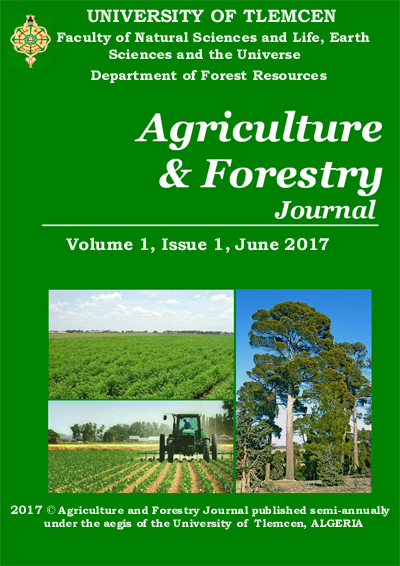Butterfly count on different habitats in international institute of tropical agriculture (IITA), Ibadan-Nigeria
DOI:
https://doi.org/10.46325/afj.v6i2.101Abstract
Butterflies are considered as good ecological indicators for other invertebrate and as surrogate representatives of environmental quality changes. Their occurrence and diversity in populations contribute to thriving ecosystems and can indicate the state of an ecosystem’s health. Though, there is high increase in habitat fragmentation of most protected area. However, information on butterfly species abundance, richness on different habitat is limited in the study area. The study assessed the diversity and abundance butterfly species in relation to its environmental factors. Sampling was done quantitatively using three complementary methods, line transect (walk-and-counts), hand nets, and fruit bait traps in June and July 2018. Data was analysed using descriptive statistics, diversity indices and Pearson’s correlation. A total of 646 individual representing 40 butterfly species belonging to 5 families in the order Lepidoptera were recorded across the three different habitats. Members of Nymphalidae family occurred most and accounted for 57.5% species and 63.3% total number of individual species with Acrsea serena been the most dominant across the habitats. Forest habitat had the highest species composition (n = 316). Generally, species abundance (31.0%), richness (33.7%) and family composition (33.7%) respectively, were recorded more through visual count method, while mean species abundance (26.1%) encountered higher with hand-net method. There was no significant relationship between the environmental factors and the total number of individuals or species richness. But rainfall was found to be positively correlated with the species diversity and abundance. Hence, understanding the factors affecting butterfly species diversity and abundance in IITA is very important for conservation purposes.
References
Adeyanju T.A., Ottosson U. Adeyanju T.E. & Omotoriogun T.C., 2014. Birds of the International Institute of Tropical Agriculture campus, a stronghold of avian diversity in the changing Ibadan area (Nigeria) over the last 50 years. Grimaldi D. and Engel M.S. 2005. Evolution of the insects. Cambridge University Press, pp. 590-606.
Akwashiki B.A., Amuga G.A., Nwansat G.S. & Ombugadu R.J., 2007. Assessment of Butterfly Diversity in Eagle Owl Gully of Amurum Forest Reserve, Jos East Local Government Area, Plateau State Nigeria. The Zoologist, 5:33-38.
Alarape A.A., Omifolaji J.K. & Mwansat G. S., 2015. Butterfly Species Diversity and Abundance inUniversity of Ibadan Botanical Garden, Nigeria. Open Journal of Ecology,5:352-360. http://dx.doi.org/10.4236/oje.2015.58029.
Aiswarya V.N., Pradarsika M. & Soma A.B., 2014. Studies on the diversity and abundance of butterfly (Lepidoptera: Rhopalocera) fauna in and around Sarojini Naidu college campus, Kolkata,West Bengal, India, Journal of Entomology and Zoology Studies, 2 (4):129-133.
Boonvanno K., 2001. Physical Effects on Butterfly Diversity at Ton Nga Chang Wildlife Sanctuary, Southern Cyprus. Science Asia, 49, 177-188.
Chapman, A.D., 2006. Numbers of living species in Australia and the World. Report for the Australian Biological Resources Study, 2nd edition. 84p.
Davies A.B. & Asner G.P., 2014. Advances in animal ecology from 3D‐LiDAR ecosystem mapping. Trends in Ecology and Evolution, (29): 681–691.
Fermon H., Waltert M., Vane-Wright R.I. & Muhlenberg M., 2005. Forest use and vertical stratification in fruit-feeding butterflies of Sulawesi, Indonesia: impacts for conservation. Biodiversity and Conservation, 14(2): 333-350.
Gascon C., Lovejoy T.E., Bierregaard R. O., Malcolm J.R., Stouffer P.C, Vasconceleos, H. L. Laurance W. F. Zim- merman, B. Tocher M.& Borges S., 1999. Matrix Habitat and Species Richness in Tropical Forest Butterflies. Biological Conservation, 91: 223-229. http://dx.doi.org/10.1016/S0006- 3207(99)00080-4
González‐Varo J.P., Biesmeijer J.C. Bommarco R., Potts S.G., Schweiger O. & Smith Vilà, M., 2013. Combined effects of global change pressures on animal‐mediated pollination. Trends in Ecology and Evolution, 28: 524-530.
Imam W., 2015. Diversity of butterflies in four different forest types in Mount Slamet, Central Java, Indonesia. Biodiversitas, 16 (2): 197-204.
Kitahara M., Yumoto M. & Kobayashi T., 2008. Relationship of butterfly diversity with nectar plant species richness in and around the Aokigahara primary woodland of Mount Fuji. Open Journal of Ecology, 5-28.
Mallet J., 2007. "Details about the Lepidoptera and Butterfly Taxome Projects". The Lepidoptera Taxome Project. University College London. Retrieved 14 November 2018.
Molleman F., Kop A., Brakefield P. M., De Vries P. J., & Zwaan. B. J., 2006. Vertical and temporal patterns of biodiversity of fruit-feeding butterflies in a tropical forest in Uganda. Biodiversity and Conservation, 15(1):107–121.
Munyuli. T.M.B., 2010. Pollinator biodiversity and economic value of pollination services in Uganda [Ph.D. Dissertation], Makerere University, Kampala, Uganda.
Nwosu L. C. & Iwu, C. J., 2011. A comparative study of diversity of species of butterflies in protected and unprotected habitats of Okwu Ogbaku forest reserve in Mbaitoli L.G.A., Imo State, Nigeria, Journal of Environmental Issues and Agriculture in Developing Countries, 3(1): 129 -135.
Ramesh T., Hussain K.J., Selvanayagam M., Satpathy K.K. & Prasad M.V.R., 2010. Patterns of Diversity, Abundance and Habitat Association of Butterflies Communities in Heterogeneous Landscapes of Department of Atomic Energy (DAE) Campus at Kalpakkam, South India. International Journal of Biodiversity and Conservation, (2)75-85.
Safian T.A. & Warren E. Y., 2015. Common butterflies of IITA. pp. 1-50.
Tews J., Brose U., Grimm V. Tielbörger K., Wichmann M. Schwager M. & Jeltsch F. 2004. Animal species diversity driven by habitat heterogeneity/diversity: The importance of keystone structures. Journal of Biogeography, 31: 79–92.
Tiple A.D. & Arun M. K. 2009. Butterfly Species Diversity, Habitats and Seasonal Distribution in and Nagpur City, Central India. Journal of Natural History, 43: 855-884 http://dx.doi.org/10.1080/002229308026 10568
Viejo. P., Paul L. & Curie N., 2000. Conservation Biology, 1st edition. 300p.
Wilson E.O., 2009. "Threats to global diversity". Retrieved 17-5-2019.
Yager G. O., Agbidye F.S. & Okoh, A.O., 2016. Diversity and Abundance of Butterfly species (Lepidoptera) Fauna in Federal University of Technology, Makurdi Forestry Nursery, Benue State, Nigeria. Journal of Research in Forestry, Wildlife and Environment, 8(3):83-89.









